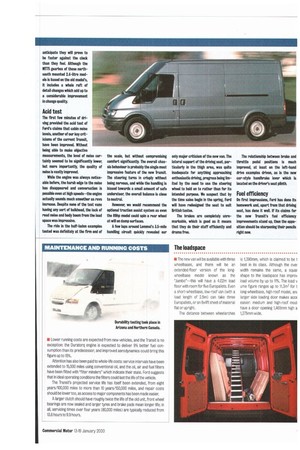111111VING IMPRESSIONS III by Cohn Barnett
Page 20

Page 21

If you've noticed an error in this article please click here to report it so we can fix it.
Our first opportunity to drive the new Transit came on a snowy morning at Ford's proving ground at Lommel in Belgium just before Christmas. Half a dozen rear wheel drive models in a variety of body versions, and with a mixture of 89 and 118hp 2.4-litre engines, were made available. All were laden with half of their maximum payload.
Opening the door provided the first surprise, as it opens much less than you would expect. although its extra length means access is not a problem. Once aboard, we spent some time absorbing the new surroundings and getting fitted in.
Steering column The steering column is not adjustable. but this is compensated by versatile seat adjustment. As well as the normal slider, which now has 30mm more rearwards travel, the seat has stepless control of backrest angle and cushion height and angle. Higher-spec models also get an armrest and pneumatic lumbar support.
Visibility in all directions is good, thanks particularly to the deep side windows and improved versions of the old model's highly praised dual-zone mirrors. The initial impression is that the cabin is everything It should be, given the amount of planning that lies behind it. Hundreds of van operators were shown mock-up vehicles and their responses were taken into account to provide as ergonomically sound a working environment as possible.
Among the changes of particular interest for the driver are a proper rotary light switch on the dash instead of the old third stalk, and a hazard light switch that doesn't require putting your arm through the steering wheel. The dash-top clipboard holder, the huge doer bins with two-litre bottle holders angled to avoid the window winders and the purpose-built mobile phone holder are bound to be appreciated by the busy van driver.
But welcome as the updated cabin is, we were in Belgium to sample the new Transit's dynamic abilities.
Driving away revealed that the electronic throttle pedal now feels like it's actually connected to the engine, unlike the current system that has a noticeable delay both on and off the power. Strangely, and we suspect due to different turbocharger characteristics, the 89hp engine actually feels more responsive than its bigger brother but neither engine displays any noticeable turbo lag. Both engines have such a flat spread of torque that we
anticipate they will prove to be faster against the clock than they feel. Although the MT75 gearbox of these northsouth mounted 2.4-litre models is based on the old model's, it includes a whole raft of detail changes which add up to a considerable improvement in change quality.
Acid test
The first few minutes of driving provided the acid test of Ford's claims that cabin noise levels, another of our key criticisms of the current Transit, have been improved. Without being able to make objective measurements, the level of noise carthinly seemed to be significantly lower, but more importantly, the quality of noise is vastly improved.
While the engine was always noticeable before, the harsh edge to the noise has disappeared and conversation is possible even at high speeds—the engine actually sounds much smoother as revs increase. Despite none of the test vans having any sort of bulkhead, the lack of road noise and body boom from the load space was impressive.
The ride in the half-laden examples tested was definitely at the firm end of the scale, but without compromising comfort significantly. The overall chassis behaviour is probably the single most impressive feature of the new Transit. The steering turns In crisply without being nervous, and while the handling is biased towards a small amount of safe understeer, the overall balance is close to neutral.
However, we would recommend the optional traction assist system as even the 89hp model could spin a rear wheel at will on damp surfaces.
A few laps around Lommel's 3.5-mile handling circuit quickly revealed our
only major criticism of the new van. The lateral support of the driving seat, particularly in the thigh area, was quite inadequate for anything approaching enthusiastic driving, progress being limited by the need to use the steering wheel to hold on to rather than for Its intended purpose. We suspect that by the time sales begin in the spring, Ford will have redesigned the seat to suit British tastes.
The brakes are completely unremarkable, which is good as it means that they do their stuff efficiently and drama free. The relationship between brake and throttle pedal positions is much improved, at least on the left-hand drive examples driven, as is the new car-style handbrake lever which Is located on the driver's seat plinth.
Fuel efficiency
On first impressions, Ford has done its homework and, apart from that driving seat, has done it well. If its claims for the new Transit's fuel efficiency improvements stand up, then the opposition should be sharpening their pencils right now.




















































































































